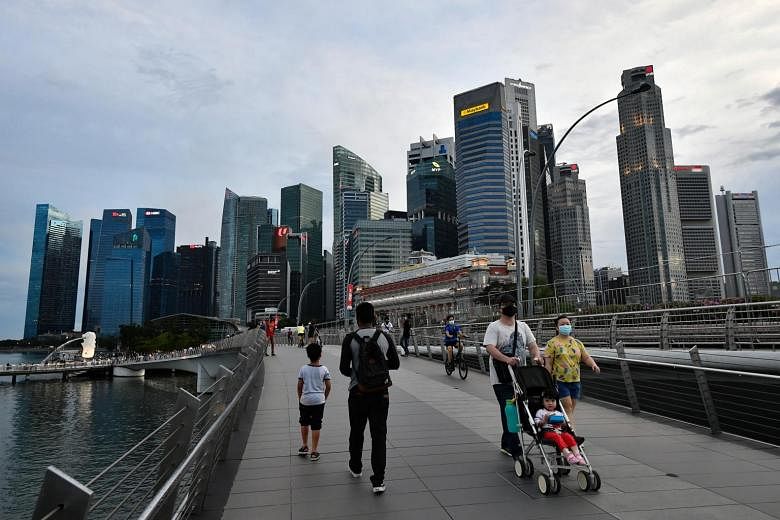With more than 70 per cent of its population fully vaccinated, Singapore has the confidence to pivot to treating Covid-19 as an endemic disease, like influenza, chickenpox and HIV. This means the coronavirus will circulate more freely within the community and may even be imported. The health authorities have pointed out that while Covid-19 will continue to cause infections - even among those vaccinated - these will mostly be mild and capable of being treated at home, thanks to the high vaccination rate.
This means the economy can continue to be opened up. As more activities are permitted, people can go out in groups, even without masks - at least outdoors. Also, larger events can resume and even some travel can be permitted.
Theoretically, this should boost the economy, bringing much relief especially to long-suffering sectors such as offline retail, the food and beverage industry and other contact-intensive services.
But in reality, human behaviours and, in particular, the degree of peoples' tolerance of personal risk will determine how quickly such sectors will bounce back.
Just because the Government mandates that unlimited numbers of diners can eat out, concerts can go live or that commercial flights will resume, it does not mean that large numbers of people will rush to restaurants, bars and social events or hop onto airplanes.
With the health impact of opening up still untested and with infections likely to rise, the return of "social consumption" - that is, consumption by groups of people - will be a gradual process that will pick up only over time, as people monitor the inevitable growth of infection clusters and their consequences.
With restrictions progressively relaxed, people will need to take more responsibility for their own safety. Slowly, and hopefully surely, their comfort levels will increase and economic activities will return - though probably not to the pre-Covid-19 normal.
Treating Covid-19 as endemic will also entail some additional costs. Hospital and community care facilities will need to be expanded and testing and contact tracing costs will go up. With the potential for infections higher, work from home arrangements will continue and some may become permanent, which will weigh on the office real estate sector. More economic activities will shift away from the central business district to suburban areas. There will also be costs associated with establishments having to remodel their facilities to minimise the spread of infections.
Impact of other countries
But most importantly, the fate of Singapore's economy does not depend only on local health data, no matter how glowing. Being as open as it is, the economy will continue to be impacted by the situation in other countries, particularly those in the region. And there the news is not good.
While Singapore may have the luxury of treating Covid-19 as endemic, the disease is still very much a pandemic in the rest of South-east Asia. About a month ago, Indonesia emerged as the new epicentre of Covid-19, overtaking Brazil and India to record the highest number of new cases and deaths. Infections driven largely by the Delta variant of the virus have also been rising sharply in Malaysia, the Philippines, Thailand and Vietnam.
With the possible exception of Malaysia, these countries are far away from being able to declare Covid-19 as being endemic. This is because their vaccination rates - in terms of the percentage of the population that is fully vaccinated - are still mostly in the single digits. As at Aug 15, they were 9.5 per cent in Indonesia, 7 per cent in Thailand, 11.1 per cent in the Philippines and only 1.5 per cent in Vietnam.
Even the more developed economies of Taiwan, South Korea, Australia and New Zealand - where infections have also been rising in recent weeks - have surprisingly low vaccination rates - ranging from 2.8 per cent in Taiwan to 20.8 per cent in Australia.
This means that Singapore's opening up to international travel will be difficult - at least to the region. The target of being able to do this by the end of September looks optimistic.
The aviation and tourism-related industries as well as the international convention business will likely remain depressed well into next year. Ditto for sectors dependent on relatively high proportions of foreign workers, such as construction and offshore marine, where the intake of such workers will have to be calibrated.
Headwinds for manufacturing
But the virulence of the pandemic in the region will also weigh on one sector that has so far been resilient: manufacturing. Over recent weeks, many South-east Asian countries have been forced to impose lockdowns that have disrupted supply chains in multiple industries.
The carmaker Toyota has had to halt production in all three of its factories in Thailand. Some of Malaysia's car plants have also had to be closed. In parts of Vietnam, the majority of factories in the furniture, textiles, apparel, footwear, electronics and related sectors have suspended operations. Many factories are still operating at lower levels of capacity than normal.
Across South-east Asia, the purchasing managers' index (PMI), which measures the state of market conditions in the manufacturing and service sectors, plunged last month to well below 50, which signals a sharp contraction. While the PMI was still in positive territory in Singapore - at 50.1 in July - this may be vulnerable to a correction if the supply chain disruptions in the region continue - which depends mainly on countries' abilities to bring infections under control in the face of low vaccination rates and stressed-out healthcare systems - a tall order as of now.
Disruptions in China
Supply chains on which most of Asia's trade depends are being further hit by increases in Covid-19 infections in China, also driven by the Delta variant. The outbreak, which was reportedly triggered by a flight from Russia to Nanjing on July 10, has spread to at least 48 cities in 18 provinces as at last Friday, according to China's National Health Commission.
While the numbers of daily infections are small - fewer than 100 - China's policy response magnifies their economic impact. China has a policy of "zero tolerance" of Covid-19 which means it refuses to accept the virus as being endemic. This has led to the imposition of draconian restrictions including tightened social distancing norms, cross-province and even cross-city travel bans and targeted lockdowns, as well as mass testing.
Many factories have been affected. The Chinese authorities are particularly strict in ensuring that ports remain virus-free which explains why they recently partially shut down the container port in Ningbo-Zhoushan - the third largest in the world - reportedly because an employee had tested positive for Covid-19. Earlier, the authorities had closed the Yantian port in Shenzhen for about a month after another small outbreak.
Such actions have both further disrupted supply chains and contributed to soaring shipping costs as more ships are stuck in ports. The Drewry Composite World Container index, which monitors ocean freight rates, has risen for 17 consecutive weeks and hit US$9,421.48 (S$12,814.15) per 40ft container in the second week of this month, 358 per cent more than in the same week last year. For some routes, the increases are far higher - for example, 636 per cent from Shanghai to Rotterdam. Drewry expects rates to rise even further.
This means higher costs for the manufacturing sector in Asia. This will, in turn, start to be reflected in the sector's growth performance from the third quarter.
How long it will take for Covid-19 to be tamed in South-east Asia is not clear - it is more likely to be months rather than weeks, even if we ignore the possible emergence of new variants.
Meanwhile, we should be wary of rosy economic projections based on Singapore's pivot to treating the virus as endemic while it is still a pandemic - or being treated as such - in the rest of the region.


